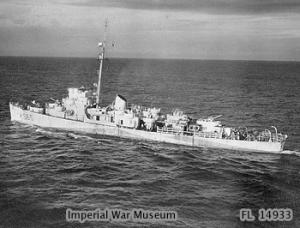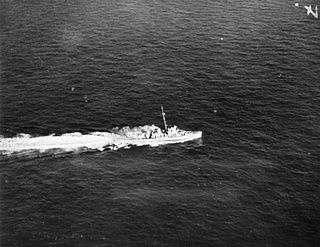The third HMS Hoste (K566), ex-Mitchell, was a Captain-class frigate of the Evarts-class of destroyer escort, originally commissioned to be built for the United States Navy. Before she was finished in 1943, she was transferred to the Royal Navy under the terms of Lend-Lease, and saw service during the World War II from 1943 to 1945.
HMS Holmes (K581) was a Royal Navy Captain-class frigate, originally a Buckley-class destroyer escort intended for the United States Navy. Before she was finished in 1944, she was transferred to the Royal Navy under the terms of Lend-Lease, and was in commission from 1944 to 1945, seeing service during World War II.
HMS Duff (K352) was a British Captain-class frigate of the Royal Navy that served during World War II. Originally constructed as the United States Navy Buckley class destroyer escort USS Lamons (DE-64), she was transferred to the Royal Navy before she was completed.

HMS Retalick (K555) was a British Captain-class frigate of the Royal Navy in commission during World War II. Originally constructed as a United States Navy Buckley class destroyer escort, she served in the Royal Navy from 1943 to 1945.

HMS Riou (K557) was a British Captain-class frigate of the Royal Navy in commission during World War II. Originally constructed as a United States Navy Buckley class destroyer escort, she served in the Royal Navy from 1943 to 1945.
HMS Rowley was a British Captain-class frigate of the Royal Navy in commission during World War II. Originally constructed as a United States Navy Buckley class destroyer escort, she served in the Royal Navy from 1943 to 1945.
The fourth HMS Rupert (K561) was a British Captain-class frigate of the Royal Navy in commission during World War II. Originally constructed as a United States Navy Buckley class destroyer escort, she served in the Royal Navy from 1943 to 1946.
The second HMS Seymour (K563) was a British Captain-class frigate of the Royal Navy in commission during World War II. Originally constructed as a United States Navy Buckley class destroyer escort, she served in the Royal Navy from 1943 to 1946.

HMS Stayner was a British Captain-class frigate of the Royal Navy in commission during World War II. Originally constructed as a United States Navy Buckley-class destroyer escort, she served in the Royal Navy from 1943 to 1945.

HMS Thornborough (K574), sometimes spelled Thornbrough, was a British Captain-class frigate of the Royal Navy in commission during World War II. Originally constructed as a United States Navy Buckley class destroyer escort, the ship served in the Royal Navy from 1943 to 1945.
HMS Tyler (K576) was a British Captain-class frigate of the Royal Navy in commission during World War II. Originally constructed as a United States Navy Buckley-class destroyer escort, she served in the Royal Navy from 1944 to 1945.
HMS Cooke (K471) was a British Captain-class frigate of the Royal Navy in commission during World War II. Originally constructed as the United States Navy Evarts-class destroyer escort USS Dempsey (DE-267), she served in the Royal Navy from 1943 to 1946.
HMS Domett (K473) was a British Captain-class frigate of the Royal Navy in commission during World War II. Originally constructed as the United States Navy Evarts-class destroyer escort USS Eisner (DE-269), she served in the Royal Navy from 1943 to 1946.

The second HMS Foley (K474) was a British Captain-class frigate of the Royal Navy in commission during World War II. Originally constructed as the United States Navy Evarts-class destroyer escort USS Gillette (DE-270), she served in the Royal Navy from 1943 to 1945 and in the U.S. Navy as USS Foley (DE-270) from August to October 1945.
HMS Gardiner (K478) was a British Captain-class frigate of the Royal Navy in commission during World War II. Originally constructed as the United States Navy Evarts-class destroyer escort USS O'Toole (DE-274), she served in the Royal Navy from 1943 to 1946.
HMS Goodall (K479) was a British Captain-class frigate of the Royal Navy in commission during World War II. Originally constructed as the United States Navy Evarts-class destroyer escort USS Reybold (DE-275), she served in the Royal Navy from 1943 until her sinking in 1945.

HMS Grindall (K477) was a British Captain-class frigate of the Royal Navy in commission during World War II. Originally constructed as the United States Navy Evarts-class destroyer escort USS Sanders (DE-273), she served in the Royal Navy from 1943 to 1945 and then in the U.S. Navy as USS Grindall (DE-273) from August to October 1945.
HMS Kingsmill (K484) was a British Captain-class frigate of the Royal Navy in commission during World War II. Originally constructed as the United States Navy Evarts-class destroyer escort DE-280, she served in the Royal Navy from 1943 to 1945 and then in the U.S. Navy as USS Kingsmill (DE-280) from August to October 1945.

HMS Loring (K565) was a British Captain-class frigate of the Royal Navy in commission during World War II. Originally constructed as the United States Navy Evarts-class destroyer escort DE-520, she served in the Royal Navy from 1943 to 1945.

The second HMS Moorsom (K567) was a British Captain-class frigate of the Royal Navy in commission during World War II. Originally constructed as the United States Navy Evarts-class destroyer escort DE-522, she served in the Royal Navy from 1943 to 1945.







